Keith arrived in New York in 1978 as a scholarship student at the School of Visual Arts. All at once, he began to experience a multicultural urban community with its own expressive vocabulary; a lively environment in which to explore his gay identity; and a peer group, at the School of Visual Arts and in the vibrantly experimental East Village, as energetic and uninhibited as Keith himself.
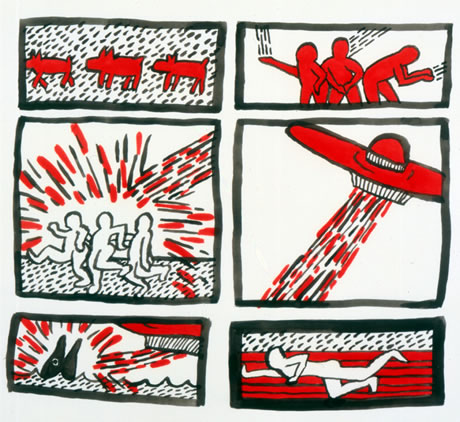
Untitled, 1980, Acrylic Spray Paint and Ink on Paper
He was particularly inspired by the beauty and spontaneity of the graffiti he saw in the subways. Graffiti spoke of a world that was hip and streetwise, creative and spontaneous and underground–all that he admired and wanted to be. At the same time, he admired the technical mastery and calligraphic quality of the graffiti artists’ ‘tags.’
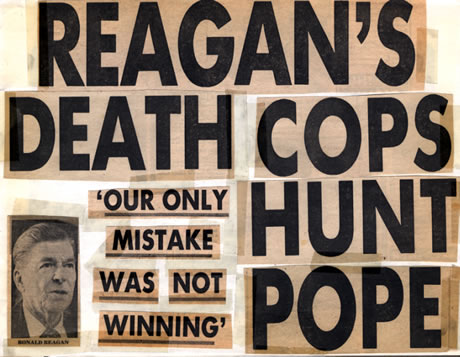
Untitled, 1980, Collage
His classes at SVA (with teachers such as Keith Sonnier, Joseph Kosuth, Barbara Buchner, and others) provided Keith with an important critical framework for his emerging style. He began to work obsessively, hanging his drawings in the hallways of the school for everyone to see. He created videotapes and performance pieces, and he also began doing a lot of writing. These experiments were part of his search for a unique style of visual communication.
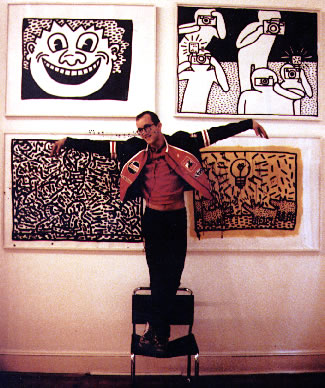
Keith Haring, 1981, photo:Klaus Wittman
“I bought a roll of oak-tag paper and cut it up and put it all over the floor and worked on this whole group of drawings. The first few were abstracts, but then these images started coming. They were humans and animals in different combinations. Then flying saucers were zapping the humans. I remember trying to figure out where this stuff came from, but I have no idea. It just grew into this group of drawings. I was thinking about these images as symbols, as a vocabulary of things. In one a dog’s being worshipped by these people. In another one the dog is being zapped by a flying saucer. Suddenly it made sense to draw on the street, because I had something to say.”[7. Sheff, p. 63]
“One day, riding the subway, I saw this empty black panel where an advertisement was supposed to go. I immediately realized that this was the perfect place to draw. I went back above ground to a card shop and bought a box of white chalk, went back down and did a drawing on it. It was perfect–soft black paper; chalk drew on it really easily.”
“I kept seeing more and more of these black spaces, and I drew on them whenever I saw one. Because they were so fragile, people left them alone and respected them; they didn’t rub them out or try to mess them up. It gave them this other power. It was this chalk-white fragile thing in the middle of all this power and tension and violence that the subway was. People were completely enthralled.”[8. Sheff, p. 63]
“I was always totally amazed that the people I would meet while I was doing them were really, really concerned with what they meant. The first thing anyone asked me, no matter how old, no matter who they were, was what does it mean?”[9. Cummings, p. 11]
“The context of where you do something is going to have an effect. The subway drawings were, as much as they were drawings, performances. It was where I learned how to draw in public. You draw in front of people. For me it was a whole sort of philosophical and sociological experiment. When I drew, I drew in the daytime which meant there were always people watching. There were always confrontations, whether it was with people that were interested in looking at it, or people that wanted to tell you you shouldn’t be drawing there…”
“I was learning, watching people’s reactions and interactions with the drawings and with me and looking at it as a phenomenon. Having this incredible feedback from people, which is one of the main things that kept me going so long, was the participation of the people that were watching me and the kinds of comments and questions and observations that were coming from every range of person you could imagine, from little kids to old ladies to art historians.”[10. Jason Rubell, “Keith Haring: The Last Interview,” Arts Magazine, September 1990, p. 59.]
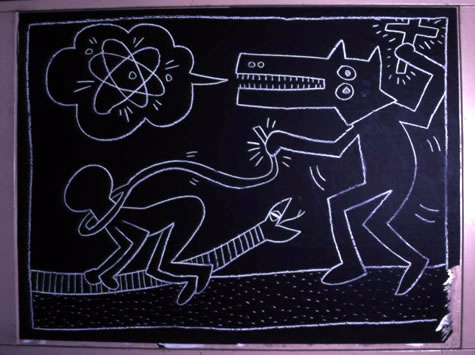
Keith Haring, Subway, 1982
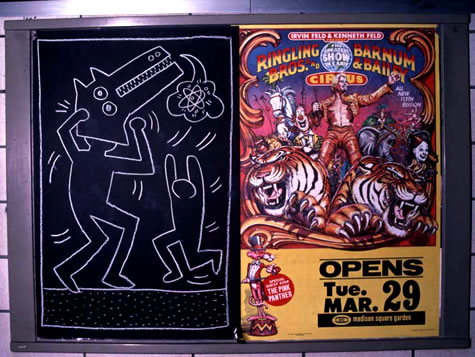
Keith Haring, Subway, 1982
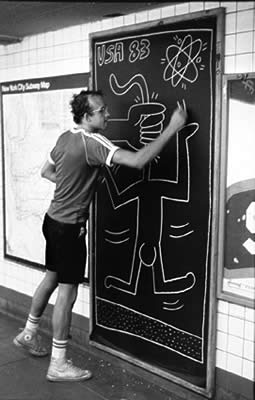
Keith Haring working in the subway. Photographer, Chantal Regnault 1983
FOOT NOTES